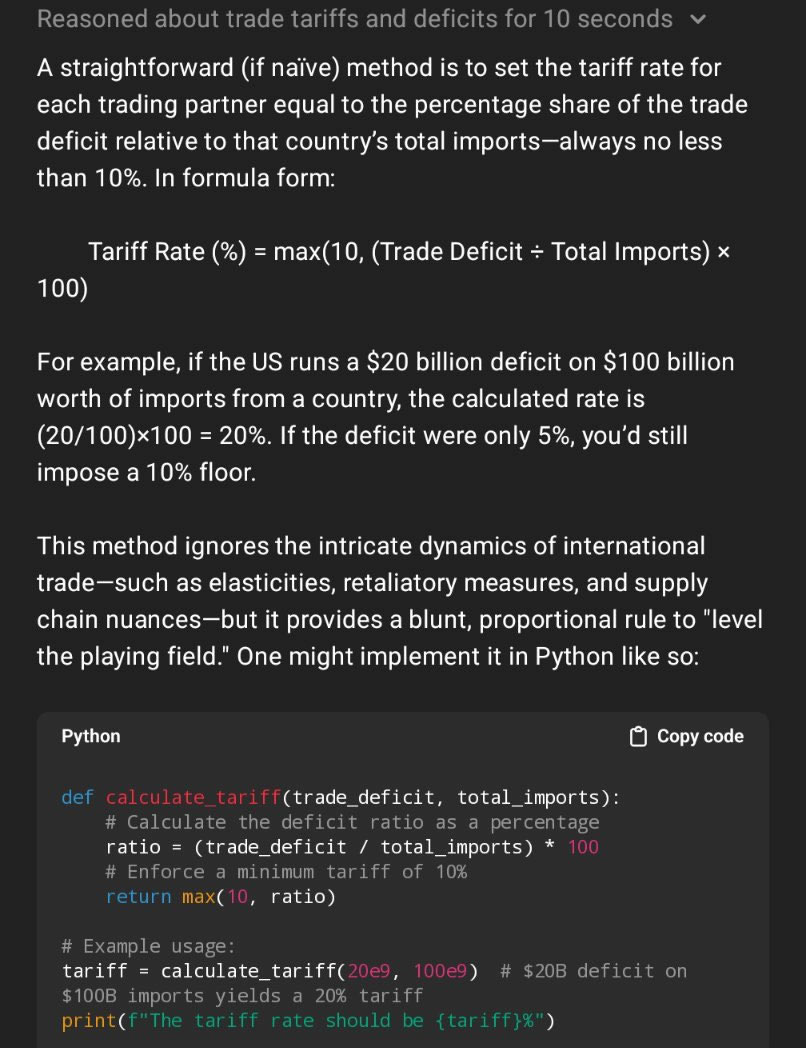A wild theory is circulating on social media suggesting that US President Donald Trump’s newly implemented reciprocal tariff strategy — imposing a minimum 10% tariff on every country — might have been crafted by an artificial intelligence chatbot.
Just after Trump revealed the tariffs during a speech in the White House Rose Garden on April 2, several users on X asserted that they were able to recreate a similar tariff structure using a basic prompt with OpenAI’s ChatGPT.
“I managed to replicate it in ChatGPT,” NFT collector DCinvestor informed his 260,000 followers on X after Trump’s announcement regarding reciprocal tariffs on 185 nations on April 2.
“It also mentioned that this idea hadn’t been established anywhere before and that it was something it came up with itself,” he continued, highlighting the chatbot’s capability to compute tariff rates. “FFS. The Trump administration is using ChatGPT to shape trade policy,” he added.
Of course, the parallels between the AI-generated tariff proposal and Trump’s own could merely be coincidental.
DCInvestor’s comment followed a query by crypto trader Jordan Fish, known as Cobie, who had also asked ChatGPT with the prompt: “What would be an easy way to calculate the tariffs that should be imposed on other countries so that the US is on even playing fields when it comes to trade deficit. Set a minimum of 10%.”

Response from ChatGPT regarding tariff calculations.
Wojtek Kopczuk, editor at the Journal of Public Economics, also tested ChatGPT and received the same results. “I believe they asked ChatGPT to compute the tariffs from other countries, which is why the tariffs make absolutely no sense,” he remarked.
Writer Krishnan Rohit speculated on X that this “might be the first large-scale application of AI technology to geopolitics.” He noted that ChatGPT, Gemini, Claude, and Grok all provided the same answer about how to set tariffs easily.
Trump’s reciprocal tariffs trigger crypto market dip
Ryan Petersen, founder and CEO of the supply chain logistics platform Flexport, stated his firm had reverse-engineered the formula utilized by the Trump administration to devise the reciprocal tariffs.
“It’s pretty straightforward; they took the trade deficit the US has with each country and divided it by our imports from that country,”
James Surowiecki, an editor at The Yale Review, echoed a similar sentiment, remarking, “they simply took our [US] trade deficit with that country and divided it by that country’s exports to us.”
Related: ‘National emergency’ as Trump’s tariffs impact crypto prices
Trump’s reciprocal tariffs, set to take effect on April 5, impose a 10% levy on all countries, with certain nations facing even higher rates, such as a 34% tariff on China, a 24% tariff on Japan, and a 20% tariff on the European Union.
The cryptocurrency markets responded adversely, plummeting 5% following the announcement, with Bitcoin (BTC) dropping by $5,500 to $82,277 before slightly recovering, according to CoinGecko.
Magazine: The era of financial nihilism in crypto is over — It’s time to aspire for greater dreams again
